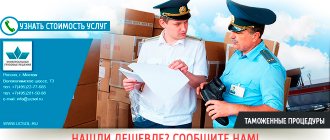Terms and cost of customs transit clearance
The transit procedure takes a few hours!
At the same time, the price or cost of services for processing the customs procedure for the customs transit of goods and cargo in our company is the minimum in the market and depends on the place of customs clearance and the tasks set by the participant in foreign trade activities, on average it can be:
- Individual – 3000 – 15000 rubles.
- Legal entity or individual entrepreneur - 5,000 - 15,000 rubles.
We are confident that the timing, cost and quality of services in our company will pleasantly surprise you!
Registration of the customs transit procedure
Ours is a customs broker (representative) and deals with the registration of customs transit of cargo and goods at any customs offices of the Russian Federation:
- At airports
- In seaports
- At railway stations
- At cargo automobile terminals – temporary storage warehouse
- Express postal items
If necessary, we carry out customs clearance of goods in any other customs procedures!
We work with any participants in foreign trade activities:
- Legal entities
- Individual entrepreneurs
Documents and information for registration of cargo and goods under the customs transit procedure (IM 80) or (EC 80)
- List of documents for registration of a Legal entity at customs (View)
- List of documents for registration of an individual entrepreneur at customs (View)
- List of documents for registration of goods and cargo under the customs procedure of customs transit (View)
Ensuring customs transit
Transportation of foreign goods
under the customs procedure of customs transit is regulated by Article 143 of the EAEU Labor Code. The declarant of the customs transit procedure must:
- Submit to the customs authority a transit customs declaration and a package of documents confirming the data declared in the declaration (status of a foreign trade participant, information about the product, information confirming the right to apply benefits and preferences when paying customs duties, etc.);
- Provide documents confirming the fulfillment of the obligation to pay customs duties;
- Provide the ability to identify goods;
- Ensure compliance with all prohibitions and restrictions provided for by the customs legislation of the Customs Union;
- Provide customs officials with access to the declared goods to carry out inspection activities.
After receiving the transit customs declaration and all shipping documents, the customs inspector endorses it by placing a personal seal in the upper right corner and assigning a unique number to the document. After this, the customs authority develops the route, determines the destination (customs authority on another section of the customs border) and the timing of delivery of the transit cargo. If there is any doubt that the cargo will be delivered to its destination intact, or if there are other risks, the head (chief) of the customs office of departure makes a decision on customs escort.
Customs procedure for customs transit of goods - features
The main feature of the customs transit procedure is that the goods being moved are not subject to taxes, as well as customs duties, special, anti-dumping or countervailing duties. But at the same time, the declarant must provide to the customs authority at the place of arrival of the cargo documents confirming the security of payment of customs duties (import customs duties, taxes, special anti-dumping and countervailing duties, if any). The amount of security for customs transit of “foreign goods” is determined based on the amount of customs duties, taxes and fees that would be payable if the customs procedure of release for domestic consumption - import 40 was applied (without taking into account possible preferences and benefits). This measure is necessary in order to prevent non-delivery of goods to the place of departure. Guarantee obligations to ensure the payment of customs duties can be provided by: customs carriers, banks, insurance companies, and some other commercial organizations that provide similar services.
The next feature of this customs procedure is that goods can only be transported by means of transport of an international carrier. Such companies operate on the basis of a certificate of admission to international transportation, and have in their fleet trucks that comply with all the requirements of the EAEU Labor Code and the rules of international transportation of goods. Only such vehicles provide the necessary degree of safety of cargo during transportation, are protected from unauthorized entry and allow sealing and sealing of cargo compartments (when transporting live animals or international mail in postal containers, sealing is not provided).





